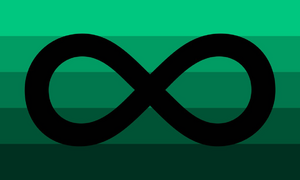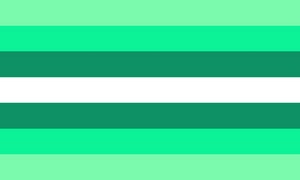Neurogender: Difference between revisions
imported>Sekhet (Removed entries for identities that were not represented by any respondents to the 2019 Gender Census. Removed entries that cited no sources.) |
imported>Sekhet (I did not find sources saying that gendervague was also called vaguegender, so I retitled its section accordingly.) |
||
| Line 39: | Line 39: | ||
==Neurogenders associated with no one specific neurotype== | ==Neurogenders associated with no one specific neurotype== | ||
=== | ===Gendervague=== | ||
[[File:vaguegender.png|thumb|Gendervague [[flags]] created by Cryptomegha.<ref name="vague coin">Cryptomegha (Gcdzilla, StrangeGloved). Untitled post. ''gcdzilla'' (blog). August 2014. https://web.archive.org/web/20141003224751/http://gcdzilla.tumblr.com/post/91603686632/ok-so-the-rly-cool-people-at-the-neurodivergentkin</ref>]] | |||
[[File:vaguegender.png|thumb| | |||
* '''Name(s):''' | * '''Name(s):''' gendervague<ref name="vague coin" /> | ||
* '''Origin:''' Coined in 2014 by Cryptomegha (Tumblr usernames StrangeGloved and Gcdzilla), together with many participants of the neurodivergentkin network.<ref name="vague coin" /> | * '''Origin:''' Coined in 2014 by Cryptomegha (Tumblr usernames StrangeGloved and Gcdzilla), together with many participants of the neurodivergentkin network.<ref name="vague coin" /> | ||
* '''Meaning:''' As originally described by its coiners, | * '''Meaning:''' As originally described by its coiners, gendervague is "a nonbinary gender that can only be used by neurodivergent people [...] it means that your gender is not definable with words because of one’s status as neurodivergent. the black and gray flag represents brain fog, as well as vagueness."<ref name="vague coin" /> Later, in 2016, autistic activist Lydia X. Z. Brown (b. 1993) wrote, "I’ve started referring to myself as gendervague, a term coined within the autistic community to refer to a specifically neurodivergent experience of trans/gender identity. For many of us, gender mostly impacts our lives when projected onto us through other people’s assumptions, but holds little intrinsic meaning. Someone who is gendervague cannot separate their gender identity from their neurodivergence – being autistic doesn’t ''cause'' my gender identity, but it is inextricably related to how I understand and experience gender. [...] For many (but certainly not all) autistic people, we can’t make heads or tails of either the widespread assumption that everyone fits neatly into categories of men and women or the nonsensical characteristics expected or assumed of womanhood and manhood. Recent research has shown that autistic people are more likely to identify as transgender or [[genderqueer]] than non-autistic people. That’s not surprising to me, because I’ve met far more trans or genderqueer people in autistic spaces than I have anywhere else."<ref name="Brown">{{Cite web |title=Gendervague: At the Intersection of Autistic and Trans Experiences |last=Brown |first=Lydia X. Z. |work=The Asperger / Autism Network (AANE) |date=22 June 2016 |access-date=9 June 2020 |url= https://www.aane.org/gendervague-intersection-autistic-trans-experiences/}}</ref> Another gendervague person, the author Max Sparrow, wrote that "gendervague helps to create a community where people understand that disability can affect gender presentation as much as or even more than inherent gender identity. Identity labels so often focus on sifting out one aspect of identity, holding it apart and separate from other aspects of our lives. Gendervague is an inherently intersected identity, honoring two different facets of identity equally, simultaneously more exclusive and more inclusive."<ref name="transtistic">Max Sparrow. "What is gendervague?" ''Transtistic: At the Intersection of Transtistic and Autgender'' (blog). June 17, 2017. Retrieved April 11, 2019. https://transtistic.wordpress.com/2017/06/17/what-is-gendervaguear Archive: https://web.archive.org/web/20190411000915/https://transtistic.wordpress.com/2017/06/17/what-is-gendervague/</ref> | ||
* '''Keywords:''' attention deficit hyperactivity disorder (ADHD), autism, dyslexia, epilepsy, gender connected with mind or brain conditions ([[neurogender]]), indefinable, indescribable, obsessive-compulsive disorder (OCD) | * '''Keywords:''' attention deficit hyperactivity disorder (ADHD), autism, dyslexia, epilepsy, gender connected with mind or brain conditions ([[neurogender]]), indefinable, indescribable, obsessive-compulsive disorder (OCD) | ||
| Line 75: | Line 60: | ||
{{Clear}} | {{Clear}} | ||
===Pendogender=== | |||
[[File:Pendogender.png|thumb|Pendogender [[Flags|flag]] created by pastelmemer.<ref>http://pride-flags-for-us.tumblr.com/post/123466666709/is-there-a-pendogender-flag</ref>]] | |||
* '''Name(s):''' pendogender | |||
* '''Origin:''' Coined in 2014 by Tumblr user pastel-memer by submission to the MOGAI-Archive blog.<ref name="pendogender coin">http://archive.is/WzKNu#selection-385.1-389.96</ref> | |||
* '''Meaning:''' As originally described by pastel-memer, it means "never being satisfied with your gender or feeling settled no matter how well it fits due to self-doubt, causing one to compulsively search and seek out something that fits even better. Gender perfectionism. The 'gender' part can be replaced by the closest fitting gender at any time, ie pendo[[list of uncommon nonbinary identities#juxera|juxera]]/pendo-[[agender]]. For neurodivergent folks only, coined with people with anxiety disorders, OCD, and OCPD in mind."<ref name="pendogender coin" /> | |||
* '''Keywords:''' anxiety, gender connected with mind or brain conditions ([[neurogender]]), Obsessive Compulsive Disorder (OCD), Obsessive-Compulsive Personality Disorder (OCPD), prefix, [[questioning]] | |||
* '''Demographics:''' In the 2019 Gender Census, one respondent.<ref name="2019 Gender Census" /> | |||
{{Clear}} | |||
==See also== | ==See also== | ||
*[[Xenogender]] | *[[Xenogender]] | ||
Revision as of 07:34, 22 July 2020
Neurogender (coined by Tumblr user Baaphomett in 2014, in a submission to the MOGAI-archive blog)[1] means any self-identity in which a person feels that their gender identity is somehow linked to-- and best described in connection with-- their neurological type (neurotype), neurological conditions, neurodivergence, mental variation, or mental illness. One's neurotype affects many parts of one's life, including one's gender identity. Neurogenders are not defined in relationship to concepts of male and female, which puts it under the umbrellas of nonbinary gender and xenogender. There are many different neurogenders related to most, if not all, neurodivergencies. Not everyone who is neurodivergent sees themselves as having a neurogender. Some neurogenders are only for people with certain neurotypes.
"Neurodivergent" is a general category for people whose neurological development and state are atypical, and it includes people who have attention deficit hyperactivity disorder (ADHD), autism, dyslexia, epilepsy, obsessive-compulsive disorder (OCD), or many other neurological conditions or mental illnesses. The word neurodivergent comes from the neurodiversity movement, which was started by autistic rights activists in the late 1990s. The neurodiversity movement seeks civil rights for neurodivergent people, and encourages seeing neurodivergence as a natural part of human diversity.[2]
In order to keep the wiki accurate to the lived experiences of neurodiverse and nonbinary people, identities should only be listed here if they cite from at least two separate external sources, showing:
1. origin (such as a source about how the term was coined, or at least history of the term's use), and
2. evidence that the identity has actually been used as someone's own identity. Acceptable evidence includes presence in at least one Gender Census result, a news article, or published nonfiction book describing an actual person using it.
A design for a pride flag does not count toward origin or evidence of use. A personal blog written by the person who coined the term or claiming to use the term does not count toward evidence of use. A source citation of a web page counts if it is either a live link, or an archive of a dead link, but dead links by themselves are not acceptable.
Neurogenders associated with autism
Autism is a spectrum of highly variable neurodevelopmental disorders. Psychologists see autism as having three main symptoms: impairments in social interaction, impairments in communication, and repetitive behavior.[3][4][5] People with autism may be impaired in some respects, but average or better in others.[6] Autism lasts lifelong from birth: it is first evident in infancy,[7] and many adults and seniors are autistic.[8][9] There is no specifically known cause (it is thought to be genetic),[10][11] prevention, or cure for autism.[12] The autistic culture and autism rights movement includes those who argue that autism should be accepted as a natural part of the diversity of kinds of people.[13][14] In the 2000s, the number of autistic people was estimated at 1–2 per 1,000 people worldwide.[15]
Autismgender
- Name(s): autismgender, autigender, or autgender.[17]
- Origin: Coined on or before Aug 25, 2014 by Tumblr users autismgender and esperancegirl by submissions to the MOGAI-Archive blog.[17]
- Meaning: A gender identity with which some nonbinary people with autism choose to use to describe themselves. As originally defined by Tumblr users autismgender and esperancegirl, autismgender means "autism as part or whole of gender identity; a gender that can only be understood in context of being autistic." When your gender experience is influenced by or linked to your autism, or your understanding of the concept of gender itself is fundamentally altered by your autism.[17]
- Keywords: autism, gender connected with mind or brain conditions (neurogender)
- Demographics: In the 2016 Nonbinary/Genderqueer Survey, one of the 3055 respondents called their gender identity "autistic," and another said "autisgender."[18] In the 2019 Worldwide Gender Census, 66 of the 11,242 respondents (0.59%) called their gender identity autigender, autgender, autistic, or autiqueer. Several of these included explanations from the survey respondants that they meant that autism was their gender, or had a significant effect on their understanding of gender.[19]
Neurogenders associated with no one specific neurotype
Gendervague
- Name(s): gendervague[20]
- Origin: Coined in 2014 by Cryptomegha (Tumblr usernames StrangeGloved and Gcdzilla), together with many participants of the neurodivergentkin network.[20]
- Meaning: As originally described by its coiners, gendervague is "a nonbinary gender that can only be used by neurodivergent people [...] it means that your gender is not definable with words because of one’s status as neurodivergent. the black and gray flag represents brain fog, as well as vagueness."[20] Later, in 2016, autistic activist Lydia X. Z. Brown (b. 1993) wrote, "I’ve started referring to myself as gendervague, a term coined within the autistic community to refer to a specifically neurodivergent experience of trans/gender identity. For many of us, gender mostly impacts our lives when projected onto us through other people’s assumptions, but holds little intrinsic meaning. Someone who is gendervague cannot separate their gender identity from their neurodivergence – being autistic doesn’t cause my gender identity, but it is inextricably related to how I understand and experience gender. [...] For many (but certainly not all) autistic people, we can’t make heads or tails of either the widespread assumption that everyone fits neatly into categories of men and women or the nonsensical characteristics expected or assumed of womanhood and manhood. Recent research has shown that autistic people are more likely to identify as transgender or genderqueer than non-autistic people. That’s not surprising to me, because I’ve met far more trans or genderqueer people in autistic spaces than I have anywhere else."[21] Another gendervague person, the author Max Sparrow, wrote that "gendervague helps to create a community where people understand that disability can affect gender presentation as much as or even more than inherent gender identity. Identity labels so often focus on sifting out one aspect of identity, holding it apart and separate from other aspects of our lives. Gendervague is an inherently intersected identity, honoring two different facets of identity equally, simultaneously more exclusive and more inclusive."[22]
- Keywords: attention deficit hyperactivity disorder (ADHD), autism, dyslexia, epilepsy, gender connected with mind or brain conditions (neurogender), indefinable, indescribable, obsessive-compulsive disorder (OCD)
- Demographics: In the 2019 Gender Census, 26 respondents (0.23%) called themselves gendervague. Three more respondents simply called their gender "vague."[19]
Pendogender
- Name(s): pendogender
- Origin: Coined in 2014 by Tumblr user pastel-memer by submission to the MOGAI-Archive blog.[24]
- Meaning: As originally described by pastel-memer, it means "never being satisfied with your gender or feeling settled no matter how well it fits due to self-doubt, causing one to compulsively search and seek out something that fits even better. Gender perfectionism. The 'gender' part can be replaced by the closest fitting gender at any time, ie pendojuxera/pendo-agender. For neurodivergent folks only, coined with people with anxiety disorders, OCD, and OCPD in mind."[24]
- Keywords: anxiety, gender connected with mind or brain conditions (neurogender), Obsessive Compulsive Disorder (OCD), Obsessive-Compulsive Personality Disorder (OCPD), prefix, questioning
- Demographics: In the 2019 Gender Census, one respondent.[19]
See also
References
- ↑ Baaphomett. "Masterpost of genders coined by Baaphomett." Mogai-Archive. Original post where these were coined, which is lost: http://mogai-archive.tumblr.com/post/91736136744/masterpost-of-genders-coined-by-baaphomett Archive of that post: https://purrloinsucks.tumblr.com/post/95720973644/masterpost-of-genders-coined-by-baaphomett Archive of that archive: https://archive.is/yULU0#selection-169.2-169.93
- ↑ "What Is: Neurodiversity, Neurodivergent, Neurotypical." Disabled World. Updated April 7, 2020. https://www.disabled-world.com/disability/awareness/neurodiversity/
- ↑ Template:Vcite book
- ↑ Filipek PA, Accardo PJ, Baranek GT, Cook EH, Dawson G, Gordon B, Gravel JS, Johnson CP, Kallen RJ, Levy SE, Minshew NJ, Ozonoff S, Prizant BM, Rapin I, Rogers SJ, Stone WL, Teplin S, Tuchman RF, Volkmar FR (1999). "The screening and diagnosis of autistic spectrum disorders". J Autism Dev Disord. 29 (6): 439–484. doi:10.1023/A:1021943802493. PMID 10638459. S2CID 145113684. This paper represents a consensus of representatives from nine professional and four parent organizations in the US.
- ↑ Geschwind, Daniel H (2009). "Advances in autism". Annu Rev Med. 60: 367–380. doi:10.1146/annurev.med.60.053107.121225. PMC 3645857. PMID 19630577.
- ↑ Pinel JP (2011). Biopsychology (8th ed.). Boston, Massachusetts: Pearson. p. 235. ISBN 978-0-205-03099-6. OCLC 1085798897.
- ↑ Rogers SJ (2009). "What are infant siblings teaching us about autism in infancy?". Autism Res. 2 (3): 125–137. doi:10.1002/aur.81. PMC 2791538. PMID 19582867.
- ↑ Steinhausen HC, Mohr Jensen C, Lauritsen MB (June 2016). "A systematic review and meta-analysis of the long-term overall outcome of autism spectrum disorders in adolescence and adulthood". Acta Psychiatrica Scandinavica. 133 (6): 445–452. doi:10.1111/acps.12559. PMID 26763353.
- ↑ Rapin I, Tuchman RF (October 2008). "Autism: definition, neurobiology, screening, diagnosis". Pediatric Clinics of North America. 55 (5): 1129–1146, viii. doi:10.1016/j.pcl.2008.07.005. PMID 18929056.
- ↑ Happé F, Ronald A (2008). "The 'fractionable autism triad': a review of evidence from behavioural, genetic, cognitive and neural research". Neuropsychol Rev. 18 (4): 287–304. doi:10.1007/s11065-008-9076-8. PMID 18956240. S2CID 13928876.
- ↑ Happé F, Ronald A, Plomin R (2006). "Time to give up on a single explanation for autism". Nature Neuroscience. 9 (10): 1218–1220. doi:10.1038/nn1770. PMID 17001340.
- ↑ Myers SM, Johnson CP (November 2007). "Management of children with autism spectrum disorders". Pediatrics. 120 (5): 1162–1182. doi:10.1542/peds.2007-2362. PMID 17967921.
- ↑ Silverman C (2008). "Fieldwork on another planet: social science perspectives on the autism spectrum". BioSocieties. 3 (3): 325–341. doi:10.1017/S1745855208006236. S2CID 145379758.
- ↑ Frith, Uta (October 2014). "Autism – are we any closer to explaining the enigma?". The Psychologist (magazine). 27. British Psychological Society. pp. 744–745. Unknown parameter
|name-list-format=ignored (help) - ↑ Newschaffer CJ, Croen LA, Daniels J, Giarelli E, Grether JK, Levy SE, Mandell DS, Miller LA, Pinto-Martin J, Reaven J, Reynolds AM, Rice CE, Schendel D, Windham GC (2007). "The epidemiology of autism spectrum disorders". Annual Review of Public Health. 28: 235–258. doi:10.1146/annurev.publhealth.28.021406.144007. PMID 17367287.
- ↑ http://pride-flags-for-us.tumblr.com/post/123783742554/fascigender-and-autigender-flags-from-the-pride
- ↑ 17.0 17.1 17.2 The since-deleted post in the mogai-archive blog where this word was coined: http://mogai-archive.tumblr.com/post/93477063574/auti-s-gender Another blog's archive of that lost blog post: http://purrloinsucks.tumblr.com/post/95723823254/autisgender An archive of that archive: https://archive.is/BTFMN#selection-489.0-489.14
- ↑ "NB/GQ Survey 2016 - the worldwide results." Gender Census. March 19, 2016. http://gendercensus.tumblr.com/post/141311159050/nbgq-survey-2016-the-worldwide-results
- ↑ 19.0 19.1 19.2 "Gender Census 2019 - the worldwide TL;DR." Gender Census. March 31, 2019. Retrieved July 5, 2020. https://gendercensus.com/post/183843963445/gender-census-2019-the-worldwide-tldr Archive: https://web.archive.org/web/20200118084451/https://gendercensus.com/post/183843963445/gender-census-2019-the-worldwide-tldr
- ↑ 20.0 20.1 20.2 20.3 Cryptomegha (Gcdzilla, StrangeGloved). Untitled post. gcdzilla (blog). August 2014. https://web.archive.org/web/20141003224751/http://gcdzilla.tumblr.com/post/91603686632/ok-so-the-rly-cool-people-at-the-neurodivergentkin
- ↑ Brown, Lydia X. Z. (22 June 2016). "Gendervague: At the Intersection of Autistic and Trans Experiences". The Asperger / Autism Network (AANE). Retrieved 9 June 2020.
- ↑ Max Sparrow. "What is gendervague?" Transtistic: At the Intersection of Transtistic and Autgender (blog). June 17, 2017. Retrieved April 11, 2019. https://transtistic.wordpress.com/2017/06/17/what-is-gendervaguear Archive: https://web.archive.org/web/20190411000915/https://transtistic.wordpress.com/2017/06/17/what-is-gendervague/
- ↑ http://pride-flags-for-us.tumblr.com/post/123466666709/is-there-a-pendogender-flag
- ↑ 24.0 24.1 http://archive.is/WzKNu#selection-385.1-389.96







